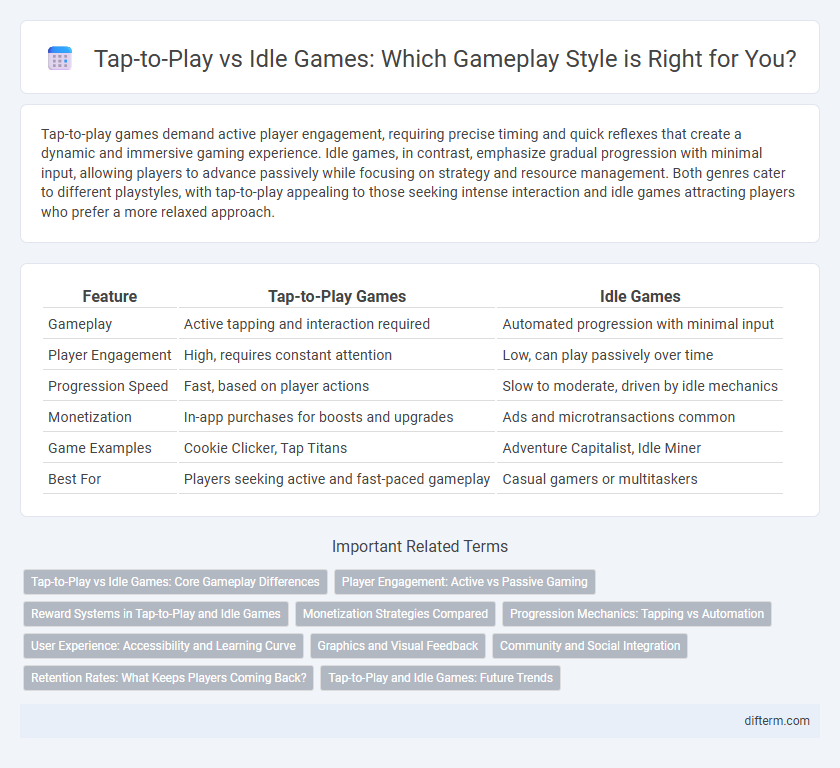Tap-to-play games demand active player engagement, requiring precise timing and quick reflexes that create a dynamic and immersive gaming experience. Idle games, in contrast, emphasize gradual progression with minimal input, allowing players to advance passively while focusing on strategy and resource management. Both genres cater to different playstyles, with tap-to-play appealing to those seeking intense interaction and idle games attracting players who prefer a more relaxed approach.
Table of Comparison
| Feature | Tap-to-Play Games | Idle Games |
|---|---|---|
| Gameplay | Active tapping and interaction required | Automated progression with minimal input |
| Player Engagement | High, requires constant attention | Low, can play passively over time |
| Progression Speed | Fast, based on player actions | Slow to moderate, driven by idle mechanics |
| Monetization | In-app purchases for boosts and upgrades | Ads and microtransactions common |
| Game Examples | Cookie Clicker, Tap Titans | Adventure Capitalist, Idle Miner |
| Best For | Players seeking active and fast-paced gameplay | Casual gamers or multitaskers |
Tap-to-Play vs Idle Games: Core Gameplay Differences
Tap-to-play games require active player interaction, demanding quick reflexes and decision-making to progress through levels or challenges, creating a dynamic and engaging gaming experience. Idle games, by contrast, emphasize passive gameplay where progression occurs automatically over time, allowing players to accumulate resources or achievements without constant input. The core gameplay difference lies in player agency: tap-to-play games prioritize continuous engagement, while idle games focus on long-term strategic planning with minimal active participation.
Player Engagement: Active vs Passive Gaming
Tap-to-play games demand continuous player interaction, fostering high engagement through real-time decision-making and skill development. Idle games operate passively, allowing progress with minimal input, which appeals to casual gamers seeking low-effort entertainment. The contrast in player engagement reflects differing cognitive involvement, with tap-to-play games enhancing active focus and idle games supporting relaxed gameplay.
Reward Systems in Tap-to-Play and Idle Games
Tap-to-play games employ reward systems that prioritize player engagement through frequent, skill-based achievements and timed bonuses, enhancing active interaction. Idle games feature passive reward structures that accumulate resources or currency automatically over time, incentivizing long-term progression without continuous input. Both systems optimize player retention by balancing immediate gratification with sustained growth mechanics tailored to different gaming behaviors.
Monetization Strategies Compared
Tap-to-play games typically rely on microtransactions and in-app purchases to monetize player engagement through incremental upgrades or customization options. Idle games often utilize ad-based revenue models, incorporating rewarded video ads and passive income mechanics that encourage periodic player interaction. Combining both strategies, developers maximize earnings by blending direct user spending with advertising income streams.
Progression Mechanics: Tapping vs Automation
Tap-to-play games emphasize active progression through continuous user interaction, where each tap contributes directly to in-game rewards and advancement. Idle games, by contrast, rely on automation mechanics that generate resources and progress passively, allowing players to achieve growth without constant input. This fundamental difference in progression mechanics shapes player engagement strategies and influences game design choices aimed at retention and monetization.
User Experience: Accessibility and Learning Curve
Tap-to-play games offer immediate engagement with straightforward controls, creating an accessible experience for users seeking quick interaction and low learning curves. Idle games provide a more passive experience, requiring minimal input while gradually rewarding players, which appeals to users who prefer low-effort gameplay and extended progression. Both game types optimize user experience by balancing accessibility and simplicity with differing levels of immersion and time commitment.
Graphics and Visual Feedback
Tap-to-play games feature dynamic, high-quality graphics designed to provide immediate visual feedback with each user interaction, enhancing player engagement through responsive animations and effects. Idle games often utilize simpler, less resource-intensive visuals that emphasize clarity and progress indicators rather than intricate graphics, allowing them to run efficiently in the background. The contrast in visual feedback between these genres highlights tap-to-play's focus on active player input versus idle games' passive progression mechanics.
Community and Social Integration
Tap-to-play games foster active communities through real-time interaction, leaderboards, and competitive events, encouraging players to engage and communicate frequently. Idle games build social integration by offering asynchronous features like guilds, resource sharing, and cooperative challenges that emphasize long-term collaboration. Both genres leverage social features, but tap-to-play favors immediate, dynamic player engagement while idle games excel in sustained, community-driven progression.
Retention Rates: What Keeps Players Coming Back?
Tap-to-play games maintain higher retention rates by offering active engagement and immediate rewards, fostering a sense of accomplishment with every interaction. Idle games appeal to players with passive progression mechanics and periodic incentives, encouraging return visits through minimal effort and consistent growth. Understanding player preferences, tap-to-play games excel in short-term retention, while idle games sustain long-term engagement by balancing activity and relaxation.
Tap-to-Play and Idle Games: Future Trends
Tap-to-play games emphasize active user engagement through frequent interaction, driving real-time decision-making and skill-based challenges that boost player retention. Idle games leverage automated progression with minimal input, appealing to casual players seeking low-effort rewards and long-term growth mechanics. Future trends suggest hybrid models combining tap-to-play's immersive dynamics with idle games' accessibility, enhanced by AI-driven personalization and blockchain-based reward systems to increase player investment and monetization opportunities.
tap-to-play vs idle games Infographic

 difterm.com
difterm.com